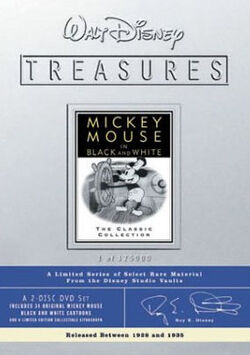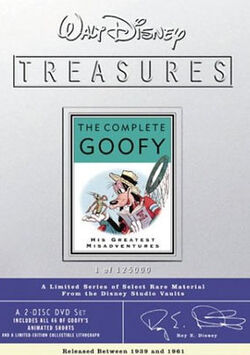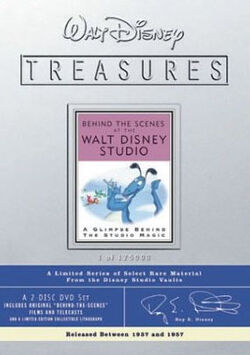The second wave of Walt Disney Treasures was released December 3, 2002. This was the final wave with the tin's individual number embossed on the tin.
Mickey Mouse in Black and White[]

This set displays a variety of Mickey Mouse cartoon shorts released in black and white.
125,000 sets produced.
Disc One[]
1928
1929
1930
1931
1932
Bonus Features
- Frank and Ollie... and Mickey: A fascinating interview between Leonard Maltin and two of the most legendary Disney artists of all time, Frank Thomas and Ollie Johnston. Even though they joined the Disney team towards the end of Mickey's days in black and white, they have a lot to say about what the character meant to them, both before and during their days with Disney.
- Two Story Scripts: These scripts first provide a look at a complete panel and then a close-up of the text and the picture on each panel. The two scripts are for "Steamboat Willie" and "Mickey Steps Out".
- Story Sketches: Various story sketch sequences from some of the cartoons presented on this disc.
- Blue Rhythm
- Mickey Cuts Up
- Mickey's Orphans
- Mickey's Nightmare
- The Whoopee Party
- Touchdown Mickey
- The Klondike Kid
- The Mickey Mouse Club: Easter egg bonus involving the Mickey Mouse Club; not the more familiar TV show of the 1950s, but an actual club popping up across the nation in 1930's. This supplement takes viewers inside those club meetings via a newsreel profiling them during the era. There's also a short that was created by Disney exclusively for these clubs: a sing-along to "Minnie's Yoo Hoo" with Mickey Mouse, complete with a second verse.
Production music used on this disc
- Promenade by David Hynes (Leonard Maltin introduction)
- Pick Me Up by Anna Karin Klockar (main menu)
- Cally by Michael Ellgren (bonus material menu)
- The Last Drink by Steve Marvin ("Frank and Ollie…and Mickey")
- Parasols On Parade by Robby Poitevin (Leonard Maltin introduction to the story sketch sequences)
- Mime Time by Giovanni Tommaso (story sketches for "Blue Rhythm")
- The Policeman by Bruno Alexiu (story sketches of "Mickey Cuts Up")
- Gold Rush by Ennio Morricone (story sketches of "Mickey's Orphans")
- The Silver Screen by David Hynes (story sketches for "Mickey's Nightmare")
- Spoon's Rag by Steve Marvin (story sketches for "The Whoopee Party")
- Amuse Me by Anna Karin Klockar (story sketches for "Touchdown Mickey")
- Tango Bar by Steve Marvin (story sketches for "The Klondike Kid")
- Whistle Stop by Giovanni Tommaso (captions menu)
Disc Two[]
1933
- Building a Building
- The Mad Doctor
- Ye Olden Days
- The Mail Pilot
- Mickey's Gala Premier
- Puppy Love
- The Pet Store
- Giantland
1934
1935
Bonus Features
- Pencil Test From The Mail Pilot: The preliminary pencil phase of a clip of the cartoon.
- Story Sketches: More story sketch sequences from some of the cartoons presented on this disc.
- Building a Building
- The Mad Doctor
- Ye Olden Days
- Puppy Love
- The Pet Store
- Giantland
- Camping Out
- Gulliver Mickey
- Orphan's Benefit
- The Dognapper
- Two-Gun Mickey
- Mickey's Service Station
- Poster Gallery: A variety of posters of many of the cartoons presented on this set.
Production music used on this disc
- Pick Me Up by Anna Karin Klockar (main menu and story sketches of "Camping Out")
- Sunny Sidewalk by Gino Peguri (bonus material menu)
- School Bus by Armand Frydman (story sketches for "Building a Building")
- Tango Loco by Armand Frydman (story sketches for "The Mad Doctor")
- Cafe Viennois by Steve Marvin (story sketches for "Ye Olden Days")
- That's My Baby by Giovanni Tommaso (story sketches for "Puppy Love")
- George & Mabel by Gino Peguri (story sketches for "The Pet Store")
- Smile by Armand Frydman (story sketches for "Giantland")
- Parasols On Parade by Robby Poitevin (story sketches of "Orphan's Benefit")
- Calamity by Franco Micalizzi (story sketches for "The Dognapper")
- Farmyard Saloon by Steve Marvin (story sketches for "Two-Gun Mickey")
- Sugar Daddy by Giovanni Tommaso (3rd full length version) (story sketches for "Mickey's Service Station")
- The Tramp by Bruno Alexiu (captions menu)
The Complete Goofy[]

This set provides a look at all of the Goofy cartoon shorts except for How to Ride a Horse (1941) (although a clip from it appears in the introduction, and the original theatrical poster is included in the Disc 2 gallery), El Gaucho Goofy (1943) (a segment from the package film Saludos Amigos), Freewayphobia #1 (1965), Goofy's Freeway Trouble (1965), and Sport Goofy in Soccermania (1987).
Note also that "Donald & Goofy" shorts Polar Trappers (1938), The Fox Hunt (1938), Billposters (1940), No Sail (1945), Frank Duck Brings 'em Back Alive (1946), and Crazy with the Heat (1947) are instead included on The Chronological Donald, Volume 1, Volume 2 and Volume 3, respectively, because they have always been put under Donald Duck's filmography instead of Goofy's.
In addition to the commentary provided by Leonard Maltin for some of the galleries on Disc 2, Goofy himself (voiced by Bill Farmer) provides some comments on others.
125,000 sets produced.
Disc One[]
- 1939
- 1940
- 1943
- 1947
- 1948
- Bonus Features
- The Essential Goof: Using a montage of clips from the various Goofy shorts on this set, the analysis of the character, as spoken by the one who originally drew him, Art Babbitt (who also created the Big Bad Wolf and the balletic mushrooms in Fantasia) is repeated here. You can view the entire analysis on the article on Goofy by clicking here. Incidentally, Art's narration is actually spoken by Earl Boen.
- The Man Behind the Goof: A mini-biography about the original voice of Goofy, Pinto Colvig. This biography reveals that in his youth, Colvig loved to travel with the circus, where he'd perform as a clown. He spent much of his life at Disney where in addition to voicing Goofy, he'd also voiced Pluto, the Practical Pig, the Grasshopper in The Grasshopper and the Ants (where Colvig, as the grasshopper, sang "The World Owes Me a Livin'", which he'd later add to Goofy) and two of the Seven Dwarfs (specifically, Grumpy and Sleepy). He also left Disney temporarily to voice Gabby at Max Fleischer's studios, but later returned to Disney where he'd spend the rest of his life voicing Goofy. He also was the original Bozo the Clown for Capitol Records on records, radio and television.
- Production music used on this disc
- Silence Is Gold by Anna Karin Klockar (Leonard Maltin introduction)
- Boogie On The Rocks by Steve Marvin (main menu)
- Promenade by David Hynes (bonus material menu)
- The Silver Screen by David Hynes (captions menu)
- Sugar Daddy by G Tommaso (Intro and end credits to the bonus materials, "The Essential Goof" and "The Man Behind the Goof.")
- Gold Rush by Ennio Morricone [BPM 3009] (bonus material: "The Essential Goof")
Disc Two[]
- 1951
- 1952
- 1961
- Bonus Features
- A Conversation With Goofy's Voice: Bill Farmer: As the title implies, Maltin interviews the present voice of Goofy, Bill Farmer, who had been voicing Goofy since 1986. Farmer reveals his origins and how he came to voice Goofy. It is revealed that Farmer had voiced Goofy in more than 3000 different Disney projects, not only cartoons, but also albums, telephones, commercials and many others.
- Poster Gallery: Many of the posters of the Goofy shorts are presented here. Curiously, Maltin does not provide commentary as he usually does on the sets; instead, it's Goofy who provides the occasional comment/exclamation.
- Memorabilia Gallery: This gallery shows off various Goofy memorabilia, such as books and albums. Maltin does do the commentary here.
- Goofy Through the Years Gallery: This gallery reveals storyboard sketches, animation drawings and background paintings of many of the Goofy shorts presented. Again, Maltin does not provide commentary; once again, it's Goofy.
- Production music used on this disc
- Alpen Safari by Steve Martin [MAT 158] (main menu)
- Burlesque by Armando Trovaioli (bonus materials menu)
- Sugar Daddy by G Tommaso (Intro and end credits to the bonus material, "A Conversation With Goofy's Voice: Bill Farmer.")
- Belles on Parade by David Hynes [MAT 158] (captions menu)
Behind the Scenes at the Walt Disney Studio[]

This set covers the process of producing films at the Walt Disney Studios from the as well as tour the studios themselves. Most of the contents are from Walt Disney anthology series.
125,000 sets produced.
Disc One[]
- A Trip Through the Walt Disney Studios (1938): This short film, made by Disney from the request of Disney's distributor at the time, RKO Radio, was included on the Snow White Platinum DVD. This film talks about the promoting of the film in general, as well as give an inside look on the inner workings of the Disney Studio, which back in the 1930s was on Hyperion Avenue. Viewers not only got to see the process of making Disney cartoons, but also the faces of some of the artists who brought them to life, many of whom went on to become famous animation legends.
- How Walt Disney Cartoons Are Made (1939): This film, also released as part of the Snow White DVD, is a more family-friendly version of A Trip Through the Walt Disney Studios, as well as be used as an even bigger way of promoting Snow White.
- The Reluctant Dragon: The crown jewel of this disc, this film shows off actor and humorist Robert Benchley as he wanders the new and improved Disney Studios in Burbank, California to try and sell Walt the idea of making a film of Kenneth Grahame's book, The Reluctant Dragon. He explores an art class, dialogue stage, sound effects stage, multiplane camera department, the paint department and finally, the story and animation departments until finally he discovers Disney has finished the cartoon version of his story.
- Bonus Features
- Leonard Maltin's Studio Tours: Actually, Maltin does not provide a tour of the studio; instead, he provides a history of the place, from the days of the Alice Comedies right up to the present day.
- Behind the Boards of Baby Weems: A rare interview with long-time Disney storyman and artist Joe Grant. Maltin discusses how Grant got his start at the studio and the unusual story-reel format of the "Baby Weems" short seen in The Reluctant Dragon. Grant reveals that "Weems" and the "Dragon" shorts from the film were both originally considered for full-length theatrical releases, but ultimately didn’t warrant the longer running time.
- The Reluctant Dragon Gallery: Several black and white stills in this gallery reveal the promotional shots of the film and its actors.
- Studio Gallery: A gallery showing off photos of the old Hyperion lot.
Disc Two[]
- The Story of the Animated Drawing: On this 1955 episode of the Disney anthology series, Walt serves as the delightful host as he discusses the history of animation from the days of the caveman to the days of some primitive mechanical animation contraptions in the 1800s that were used to experiment with the art form. Then it moves on to more advance types of animation experiments, such as in J. Stuart Blackton's Humorous Phases of Funny Faces, Winsor McCay's Gertie the Dinosaur and even a demonstration of how music was synchronized into cartoons way back in the early days of the cinema.
- The Plausible Impossible: On this 1956 episode of the anthology series, Walt explains how his animators make the impossible seem realistic through various cartoons with Mickey and Donald. This episode also includes a pencil-test form of one scene from Snow White that was ultimately not used in the final film.
- Tricks of Our Trade: On this 1957 episode of the anthology series, Walt dwells on how animators study real life to create their illustrations. Examples are given from Fantasia on following a live ballerina to draw the animals' movements in Dance of the Hours, and copying actual bubbles to produce the boiling lava in The Rite of Spring. The groundbreaking multiplane camera is shown off, demonstrating how it is used to mimic real landscapes, since plain animated backgrounds seem to be too plain and create a false effect.
- Bonus Features
- Kem Weber Gallery: This gallery has architectural concept art for the Burbank lot.
- Tour of the Disney Studio: This is a rare half-hour radio broadcast from Australia in 1946, in which studio personnel Homer Brightman, Harry Reeves, Eric Larson, and Walt himself offer general information on the making of the animated films at the time.
| This page uses content from the English Wikipedia page Walt Disney Treasures: Wave Two. The list of authors can be seen in the page history. Text from Wikipedia is available under the Creative Commons Attribution-ShareAlike License; additional terms may apply. |
